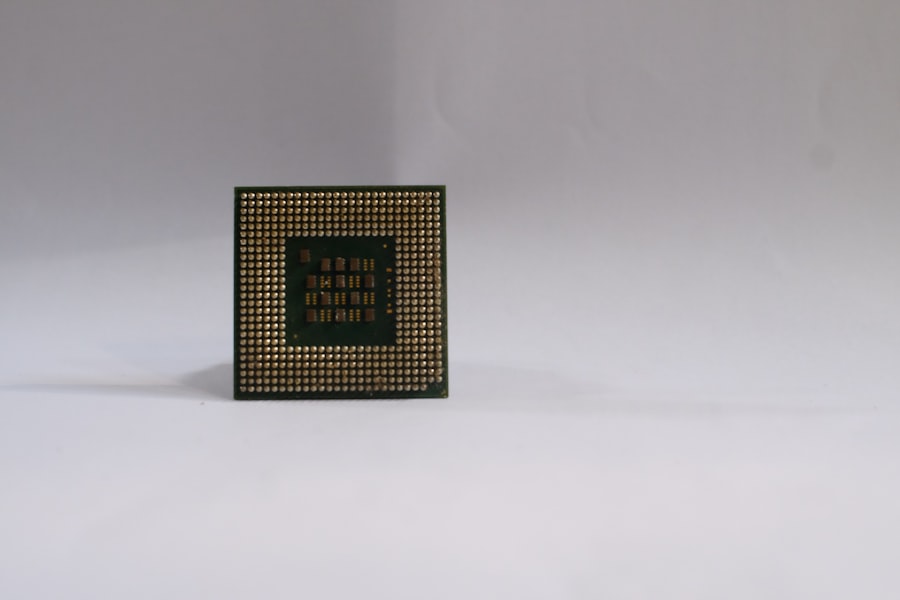In the realm of computing, the processor serves as the heart of a laptop, orchestrating the myriad tasks that users demand from their devices. Often referred to as the Central Processing Unit (CPU), this component is responsible for executing instructions and processing data, making it a critical element in determining a laptop’s overall performance. The evolution of laptop processors has been remarkable, transitioning from simple, single-core designs to complex, multi-core architectures that can handle multiple tasks simultaneously.
This transformation has been driven by the increasing demands of software applications, the rise of mobile computing, and the need for energy efficiency. The significance of laptop processors extends beyond mere speed; they influence everything from battery life to thermal management. As users engage in more resource-intensive activities such as gaming, video editing, and software development, the role of the processor becomes even more pronounced.
Understanding the intricacies of laptop processors is essential for consumers looking to make informed purchasing decisions. With a plethora of options available on the market, it is crucial to grasp how different specifications and architectures can impact performance and usability.
Understanding Processor Specifications
When evaluating laptop processors, several key specifications come into play that can significantly affect performance. Clock speed, measured in gigahertz (GHz), indicates how many cycles a processor can execute per second. While higher clock speeds often correlate with better performance, they are not the sole determinant of a processor’s capabilities.
For instance, a dual-core processor with a clock speed of 3.0 GHz may outperform a quad-core processor with a clock speed of 2.5 GHz in certain tasks due to differences in architecture and efficiency. Another critical specification is the number of cores and threads. Modern processors typically feature multiple cores, allowing them to handle several tasks simultaneously.
A quad-core processor can manage four threads at once, while hyper-threading technology enables each core to handle two threads, effectively doubling the number of tasks it can process concurrently. This multi-threading capability is particularly beneficial for applications designed to leverage parallel processing, such as video rendering or 3D modeling software. Cache size is another important specification that affects performance.
The cache is a small amount of high-speed memory located on the processor itself, used to store frequently accessed data and instructions. A larger cache can reduce latency and improve overall processing speed by minimizing the time it takes for the CPU to retrieve data from the main memory. Additionally, thermal design power (TDP) is a specification that indicates how much heat a processor generates under load, which directly impacts cooling requirements and battery life.
Performance vs Power Efficiency

In recent years, the balance between performance and power efficiency has become a focal point in laptop processor design. As users increasingly prioritize portability and battery life, manufacturers have sought to create processors that deliver high performance without excessive power consumption. This shift has led to the development of energy-efficient architectures that can dynamically adjust their performance based on workload demands.
For example, Intel’s Core i7 processors feature Turbo Boost technology, which allows them to increase clock speeds temporarily when needed while reducing power consumption during lighter tasks. This dynamic scaling ensures that users can enjoy robust performance during demanding applications while preserving battery life during everyday activities like web browsing or document editing. Similarly, AMD’s Ryzen processors utilize Precision Boost technology to optimize performance based on thermal and power conditions.
The trade-off between performance and power efficiency is particularly evident in mobile computing scenarios. Users engaged in gaming or video editing may require maximum processing power, while those using their laptops for basic tasks may benefit more from energy-efficient designs that extend battery life. As a result, many modern processors are designed with hybrid architectures that combine high-performance cores with energy-efficient cores, allowing for seamless transitions between demanding and light workloads.
Types of Laptop Processors
| Processor Type | Performance | Power Consumption |
|---|---|---|
| Intel Core i3 | Good for basic tasks | Low |
| Intel Core i5 | Balanced performance | Medium |
| Intel Core i7 | High performance | High |
| AMD Ryzen 3 | Good for budget laptops | Low |
| AMD Ryzen 5 | Good for mid-range laptops | Medium |
| AMD Ryzen 7 | High performance | High |
Laptop processors can be broadly categorized into several types based on their intended use and architecture. The most common categories include mainstream processors, ultra-low power processors, and high-performance processors. Mainstream processors are designed for general-purpose computing tasks and are suitable for everyday use, including web browsing, office applications, and multimedia consumption.
Examples include Intel’s Core i5 and AMD’s Ryzen 5 series. Ultra-low power processors are optimized for energy efficiency and are typically found in ultraportable laptops and devices designed for extended battery life. These processors prioritize low power consumption over raw performance, making them ideal for users who primarily engage in light tasks such as email and document editing.
Intel’s Core m series and AMD’s Ryzen U series exemplify this category. High-performance processors cater to users with demanding computing needs, such as gamers and content creators. These processors often feature higher clock speeds, more cores, and larger caches to handle resource-intensive applications effectively.
Intel’s Core i9 and AMD’s Ryzen 9 series are prime examples of high-performance processors designed to deliver exceptional processing power for gaming, video editing, and other demanding tasks.
Comparing Processor Brands
When it comes to laptop processors, two dominant brands have emerged: Intel and AMD. Each brand has its strengths and weaknesses, making it essential for consumers to understand their differences when choosing a laptop. Intel has long been recognized for its strong single-threaded performance and robust ecosystem of software optimization.
Its processors are widely used in various devices and are often favored by professionals who rely on specific applications optimized for Intel architecture. On the other hand, AMD has made significant strides in recent years with its Ryzen series of processors. Known for offering competitive multi-threaded performance at attractive price points, AMD has gained popularity among gamers and content creators seeking value without compromising on performance.
The introduction of AMD’s Zen architecture marked a turning point for the brand, allowing it to compete effectively with Intel in both performance and efficiency. Benchmarking tools such as Cinebench and Geekbench provide valuable insights into how these brands stack up against each other in real-world scenarios. For instance, while Intel processors may excel in single-threaded tasks like gaming, AMD processors often outperform them in multi-threaded applications such as video rendering or 3D modeling due to their higher core counts.
Ultimately, the choice between Intel and AMD will depend on individual use cases and preferences.
Future Trends in Laptop Processors

The landscape of laptop processors is continually evolving as technology advances and user demands change. One notable trend is the increasing integration of artificial intelligence (AI) capabilities into processors. Manufacturers are beginning to incorporate dedicated AI cores into their designs to enhance machine learning tasks and improve overall system responsiveness.
This trend is expected to revolutionize how laptops handle tasks such as image recognition, natural language processing, and predictive analytics. Another significant trend is the shift towards heterogeneous computing architectures that combine different types of processing units within a single chip. This approach allows for greater flexibility in handling diverse workloads by leveraging specialized cores optimized for specific tasks alongside traditional CPU cores.
For example, Apple’s M1 chip integrates CPU cores with GPU cores and neural engine cores to deliver exceptional performance across various applications while maintaining energy efficiency. Additionally, advancements in manufacturing processes are leading to smaller transistors and increased transistor density on chips. This miniaturization enables higher performance levels while reducing power consumption and heat generation.
As manufacturers continue to push the boundaries of semiconductor technology with innovations like 3nm process nodes, we can expect even more powerful and efficient laptop processors in the coming years.
Factors to Consider When Choosing a Laptop Processor
Selecting the right laptop processor involves considering several factors that align with individual needs and usage scenarios. First and foremost is understanding the primary use case for the laptop. Users who primarily engage in basic tasks such as web browsing or word processing may find that an ultra-low power processor suffices for their needs.
In contrast, gamers or content creators will likely require high-performance processors capable of handling demanding applications. Budget is another critical consideration when choosing a laptop processor. High-performance models often come with a premium price tag, so it’s essential to balance performance requirements with financial constraints.
Consumers should also consider future-proofing their investment by opting for processors with higher core counts or advanced features that may become increasingly relevant as software demands evolve. Thermal management is also an important factor to consider when selecting a laptop processor. High-performance processors generate more heat than their ultra-low power counterparts, necessitating effective cooling solutions to maintain optimal performance without throttling.
Users should pay attention to reviews that assess thermal performance and battery life under load conditions to ensure they choose a laptop that meets their expectations.
Conclusion and Recommendations
In navigating the complex landscape of laptop processors, consumers must equip themselves with knowledge about specifications, performance characteristics, and brand comparisons to make informed decisions tailored to their unique needs. As technology continues to advance rapidly, staying abreast of trends such as AI integration and heterogeneous computing will be crucial for those looking to invest in future-proof devices. Ultimately, whether one opts for an Intel or AMD processor will depend on specific use cases—be it gaming, content creation, or everyday productivity tasks—and budget considerations should guide choices accordingly.
By carefully evaluating these factors alongside personal preferences, users can select laptops equipped with processors that not only meet their current needs but also adapt to future demands in an ever-evolving digital landscape.
FAQs
What factors should I consider when choosing a laptop processor in 2025?
In 2025, when choosing a laptop processor, you should consider factors such as the processor’s performance, power efficiency, integrated graphics capabilities, and compatibility with other hardware components.
What are the different types of laptop processors available in 2025?
In 2025, the different types of laptop processors available include Intel’s Core series, AMD’s Ryzen series, and Apple’s custom-designed processors for MacBooks.
How do I determine the performance of a laptop processor in 2025?
In 2025, you can determine the performance of a laptop processor by looking at its clock speed, core count, cache size, and benchmark scores from reputable sources.
What is the importance of power efficiency in a laptop processor in 2025?
In 2025, power efficiency is important in a laptop processor as it directly impacts battery life and heat generation, which can affect the overall user experience and portability of the laptop.
What role does integrated graphics play in a laptop processor in 2025?
In 2025, integrated graphics in a laptop processor are important for tasks such as video playback, photo editing, and light gaming, as they eliminate the need for a dedicated graphics card and can help reduce power consumption.
How can I ensure that the laptop processor I choose is compatible with other hardware components in 2025?
In 2025, you can ensure compatibility by checking the processor’s socket type, chipset support, and motherboard specifications to ensure that it is compatible with other hardware components such as RAM and storage devices.



MOST COMMENTED
Apps
10 Hidden Android Apps: Boost Productivity Instantly
Apps
Privacy-Focused Messaging Apps: A 2025 Comparison
Apps
Top Minimalist Apps for a Distraction-Free Life
Apps
Top Offline Apps for 2025: No Internet Needed
Gadget
The Battle of Wearables: Smart Rings vs. Smartwatches
Gadget
The Future of Mental Health: Wearable Gadgets on the Rise
Laptops
Top Laptops for Coding and Content Creation Under ₹70,000